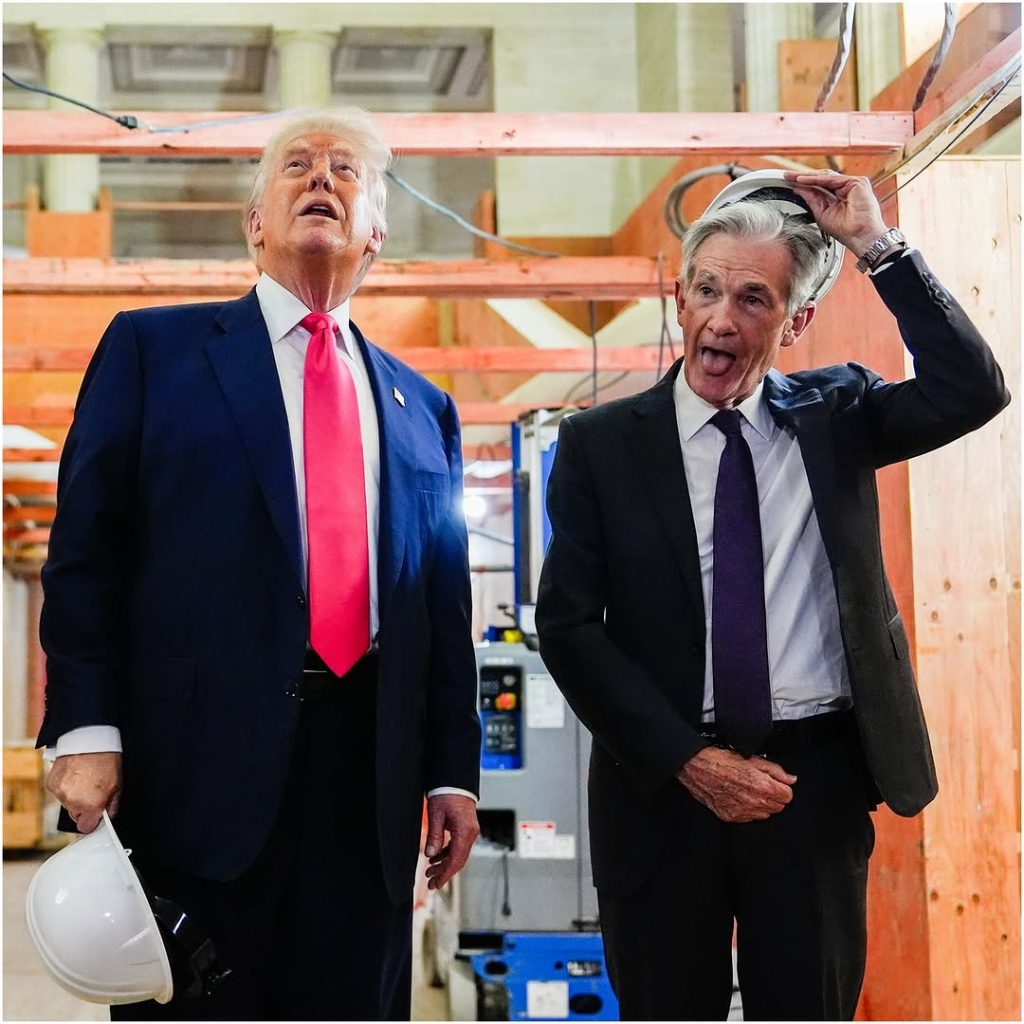Your cart is currently empty!
Everyone’s Saying the Same Thing After Trump Awkwardly Bickers on Live TV With Fed Chair Over Budget

A brief exchange between President Donald Trump and Federal Reserve Chair Jerome Powell is witching both political circles and the online world. During a rare presidential visit to the Fed’s Washington headquarters, cameras caught Trump challenging Powell over the cost of a major addition design while Powell forcefully dissented. What began as a discussion about structure charges snappily came a viral moment, raising questions about political pressure on the central bank, the state of the US frugality, and the growing spectacle of leadership under public scrutiny.
Tense Fed Visit: Trump and Powell’s On-Camera Clash
Inside the under construction halls of the Federal Reserve’s Washington headquarters, President Donald Trump brazened Federal Reserve Chair Jerome Powell in what snappily came a defining on‑camera moment. The occasion took place during Trump’s infrequently seen presidential visit to the Fed on July 24, 2025. The pressure unfolded as Trump challenged the Fed over addition costs, claiming they had ballooned to $ 3.1 billion, while Powell still but forcefully corrected him. “I am not aware of that,” Powell said, shaking his head, before reviewing a document and clarifying, “You just added in a third building is what that is — that’s a third building,” affirming that the Martin Building had been built and completed five years ago.
Despite the clash, Trump said subsequently that he does not intend to fire Powell. “To do that is a big move, I just don’t think it’s necessary,“ he remarked, adding that he still believes that “…he’s going to do the right thing.” However, Trump made clear he expects rate cuts, telling journalists, “I’d love him to lower interest rates” and latterly emphasizing that “…interest rates have to come down.”
This confrontation emerges amid months of Trump raising criticisms he has directed at Powell as a “numbskull,” and constantly prompting the Fed to cut borrowing costs markedly from its current 4.3% rate. According to sanctioned Fed reports, additional costs have risen from $1.9 billion in 2022 to roughly $2.5 billion, not the $3.1 billion the president cited. The increase is attributed to unanticipated asbestos abatement, seismic upgrades, material price inflation, and historic-preservation conditions.
The visit’s timing is notable as it precedes a crucial Federal Open Market Committee meeting, where policymakers are extensively anticipated to leave interest rates unchanged in the 4.25% to 4.50% range. Analysts say the administration’s overt pressure on the Fed carries emblematic weight indeed if the central bank remains fairly defended from political influence.
Inside the Trump–Powell Power Struggle
The confrontation between President Donald Trump and Federal Reserve Chair Jerome Powell stems from times of pressure between political priorities and central bank independence. Understanding their backgrounds provides clarity on why this clash reverberated so explosively with the public and fiscal markets.
Donald Trump: A President with a Business Lens
Donald Trump, now in his second nonconsecutive term, approaches the administration with a mindset shaped by decades in real estate development and public media presence. He constantly evaluates civil systems and profitable policy through the lens of cost, effectiveness, and request impact. Trump has long supported lower interest rates, arguing that cheaper borrowing supports consumer spending, mortgage availability, and government debt operations. His open review of the Federal Reserve reflects his belief that the institution’s conservative approach has slowed implicit profitable earnings.
Jerome Powell: The Cautious Steward of Monetary Policy
Jerome “Jay” Powell, appointed as Federal Reserve Chair by Trump in 2017 and reappointed by President Joe Biden, represents a differing style. With a professional background in investment banking and public finance, Powell has prioritized stability and data-driven decision making. He regularly emphasizes that the Fed’s accreditation is to maintain stable prices and support maximum employment, not to respond to political pressure. Indeed, in the face of pointed public review, Powell maintains a reticent public posture, allowing sanctioned statements and policy opinions to convey the institution’s stance.

A Relationship Marked by Public and Private Friction
The Trump–Powell dynamic has repeatedly drawn attention as a rare example of public tension between a president and the head of the central bank. Trump’s use of strong language, including calling Powell a “numbskull” stands in contrast to Powell’s reserved communication style. Both men have honored the significance of maintaining institutional credibility. Yet the disunion has boosted as their precedences diverge — Trump pushing for immediate rate cuts versus Powell’s emphasis on measured, independent decision making. Economists advise that repeated high-profile competitions risk unsettling requests by casting mistrust on the central bank’s autonomy.
Market Reactions and Public Response
The highly publicized exchange between President Trump and Fed Chair Jerome Powell quickly drew the attention of financial markets, analysts, and the public. While the moment sparked widespread discussion online, market responses were measured, reflecting a combination of resilience and caution.
Financial Markets Held Firm, With Brief Ripples
Market indicators muted the drama. Following the Fed visit, the yield on the benchmark 10‑year Treasury note ticked slightly higher, interpreted as investors anticipating rate cuts, while the S&P 500 and Dow Jones held steady, indicating confidence in the Fed’s forthcoming rate decision. The subdued response suggested that markets had already accounted for Trump’s fiscal rhetoric and likely monetary restraint.
Investors continued to analyze various scenarios including Powell being fired, stepping down early, or serving out his term — each considered for its market impact. Recent volatility, including a 0.7% S&P drop after firing rumors, served as a potential benchmark for investor reactions.
Analysts Stress Risks to Central Bank Independence
Experts universally cautioned that while the market response remained stable for now, any real alteration to the Fed’s leadership could significantly unsettle investor confidence. “Financial markets have sent clear warning signals about the consequences of political interference,” said Jack Ablin, chief investment officer at Cresset Capital.

Deutsche Bank strategists projected that in the event of Powell’s removal, the dollar could fall up to 6%, the 10‑year yield rise by 20 basis points, and the 30‑year yield climb by as much as 45 basis points, reflecting anticipated “inflation uncertainty and a steeper yield curve.”
Public and Media Response
Major outlets quickly highlighted the unconventional nature of Trump’s visit and the broader implications. According to The Washington Post, Trump surprised observers by later referring to Powell as a “very good man,” offering what some analysts called a restrained tone. Despite this, the coverage noted that the Fed maintained its independence, and media commentary largely framed the visit as a public relations standing test for both men.
On X( formerly Twitter) and other platforms, the footage of the exchange went viral under hashtags like #TrumpVsPowell. Clips of Trump checking his papers and Powell calmly rebutting came memes overnight, illustrating the artistic resonance of this moment.
Public opinion quickly polarized: Trump supporters praised his direct oversight and cost-control messaging, while many critics voiced concern that the spectacle risked undermining confidence in the Fed’s impartiality.
Many social media users applauded Powell for holding his ground amid political pressure. @cryptoGlitchK remarked, “Looks like Powell’s standing his ground. This drama is just getting started!”
Similarly, @Raffael_AI described Powell’s refusal to comply with Trump’s demands as “a power move.”
Others, still, blamed Powell’s leadership and questioned his credibility. @GlendaGalvez4 called him a “chair filler,” urging him to either “resign or else sit down and listen to reason.”
@LisaCappiello08 indicted Powell of political inconsistency, noting that he “had no problem lowering the interest rate for the Biden administration” despite historic inflation.
The polarized reactions highlight the growing tension between the Federal Reserve and the administration, as debates over economic policy and political influence continue to unfold in the public sphere.
How to Stay Informed Without Getting Misled
Staying informed in today’s news cycle can be tricky. Captions and viral clips frequently spark strong responses, but they don’t always tell the full story. By approaching the news with a clear and curious mindset, you can cut through the noise and concentrate on what truly matters to you.
- Read beyond the headline. Headlines grab attention but rarely capture the full story. Reading or watching the complete report provides the environment demanded to understand events directly.
- Check multiple sources. Compare content from different outlets to spot bias, avoid echo chambers, and form a well-rounded perspective.
- Rely on credible voices. Prioritize vindicated intelligencers, experts, and sanctioned statements over viral posts or anonymous accounts.
- Pause before sharing. Only share information once you are sure it is accurate and relevant to prevent the spread of misinformation.
- Focus on what matters to you. Pay attention to developments that affect your daily life, like price changes, local policies, and community updates, instead of reacting to every debate.
With headlines racing past faster than we can process, staying informed requires tolerance and perceptiveness. By reading beyond the face, vindicating information, and fastening on what truly affects your life, you gain further clarity.
Finding Clarity Amid the Chaos
Trump’s attacks on the Federal Reserve were not just political theater, given that it gurgled through Wall Street, left people uneasy, and reminded us how quickly confidence can crack in a world that reacts in seconds.
Stocks fell, experts argued, and social media turned it into a spectacle. But when the noise settled, one verity stood out: understanding the forces behind the noise, especially policy decisions, market signals, and credible reporting, will empower you to respond with perspective and not panic.
Featured Image from @julia.nikhinson on Instagram
